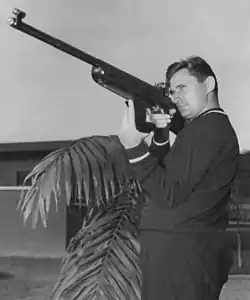Shooting at the 1956 Summer Olympics – Men's 300 metre free rifle, three positions
The men's 300 m rifle three positions was a shooting sports event held as part of the Shooting at the 1956 Summer Olympics programme. It was the seventh appearance of the event at an Olympic Games. The competition was held on 1 December 1956, with 20 shooters from 14 nations competing.[1] Nations had been limited to two shooters each since the 1952 Games. The event was won by Vasily Borisov of the Soviet Union, the nation's second consecutive victory in two appearances (tying Switzerland for most gold medals in the event). The Soviets finished 1–2, with Allan Erdman taking silver. Vilho Ylönen of Finland earned the bronze.
| Men's 300 metre free rifle, three positions at the Games of the XVI Olympiad | ||||||||||
|---|---|---|---|---|---|---|---|---|---|---|
 Vasily Borisov (1954) | ||||||||||
| Venue | Melbourne, Australia | |||||||||
| Date | 1 December | |||||||||
| Competitors | 20 from 14 nations | |||||||||
| Winning score | 1138 OR | |||||||||
| Medalists | ||||||||||
| ||||||||||
| Shooting at the 1956 Summer Olympics | |
|---|---|
 | |
| Rifle | |
| 300 metre rifle | men |
| 50 m rifle, three positions | men |
| 50 m rifle, prone | men |
| Pistol | |
| 25 m rapid fire pistol | men |
| 50 metre pistol | men |
| Shotgun | |
| Trap | men |
| Running deer | |
| 100 m running deer | men |
Background
This was the seventh appearance of the men's 300 metre three-positions rifle event, which was held 11 times between 1900 and 1972.[2] Only one of the top 10 shooters from 1952 returned: fifth-place finisher Vilho Ylönen of Finland. Reigning gold medalist and 1954 world champion Anatoli Bogdanov opted to compete only in small-bore events in 1956. This left his countryman Vasily Borisov, the runner-up at the world championship, as the favorite.[3]
The Republic of China, Pakistan, the Philippines, Romania, and South Korea each made their debut in the event. Denmark and Norway did not compete in the event for the first time; the Danes and Norwegians had competed in each of the first six appearances of the three-positions competition. Finland, Sweden, and the United States each made their sixth appearance, tied with Norway and Denmark for most appearances.
Competition format
The competition had each shooter fire 120 shots, 40 shots in each of three positions: prone, kneeling, and standing. Shots were fired in series of 10. The target was 1 metre in diameter, with 10 scoring rings; targets were set at a distance of 300 metres. Thus, the maximum score possible was 1200 points. Any rifle could be used.[3][4]
Records
Prior to the competition, the existing world and Olympic records were as follows.
| World record | 1143 | 1955 | ||
| Olympic record | 1123 | Helsinki, Finland | 27 July 1952 |
Vasily Borisov broke the Olympic record with 1138 points to win. All three medalists were above the old record. Borisov also set a world record in the prone position, with 396 points.[5]
Schedule
All times are Australian Eastern Standard Time (UTC+10)
| Date | Time | Round |
|---|---|---|
| Saturday, 1 December 1956 | 9:00 | Final |
Results
| Rank | Shooter | Nation | Score | Notes | |||
|---|---|---|---|---|---|---|---|
| Prone | Kneeling | Standing | Total | ||||
| Vasily Borisov | 396 WR | 383 | 359 | 1138 | OR | ||
| Allan Erdman | 392 | 385 | 360 | 1137 | |||
| Vilho Ylönen | 387 | 382 | 359 | 1128 | |||
| 4 | Jorma Taitto | 392 | 379 | 349 | 1120 | ||
| 5 | Constantin Antonescu | 386 | 374 | 341 | 1101 | ||
| 6 | John Sundberg | 384 | 367 | 343 | 1094 | ||
| 7 | Anders Kvissberg | 389 | 362 | 342 | 1093 | ||
| 8 | James Smith | 381 | 368 | 333 | 1082 | ||
| 9 | Sándor Krebs | 379 | 364 | 335 | 1078 | ||
| 10 | Herbert Voelcker | 385 | 355 | 335 | 1075 | ||
| 11 | Gerald Ouellette | 370 | 357 | 339 | 1066 | ||
| 12 | Rubén Váldez | 373 | 338 | 333 | 1044 | ||
| 13 | Martin Gison | 387 | 368 | 288 | 1043 | ||
| 14 | Guillermo Baldwin | 379 | 359 | 302 | 1040 | ||
| 15 | Wu Tao-yan | 370 | 349 | 306 | 1025 | ||
| 16 | Ian Wrigley | 382 | 350 | 289 | 1021 | ||
| 17 | Norman Goff | 372 | 343 | 295 | 1010 | ||
| 18 | Steffen Cranmer | 356 | 336 | 307 | 999 | ||
| 19 | Chu Hwa-il | 338 | 286 | 279 | 903 | ||
| 20 | Saifi Chaudhry | 84 | — | 183 | 267 | ||
References
- "Shooting at the 1956 Melbourne Summer Games: Men's Free Rifle, Three Positions, 300 metres". sports-reference.com. Archived from the original on 18 April 2020. Retrieved 18 February 2015.
- The event was open to women in 1968 and 1972.
- "Free Rifle, Three Positions, 300 metres, Men". Olympedia. Retrieved 10 December 2020.
- Official Report, p. 570.
- Official Report, p. 563.